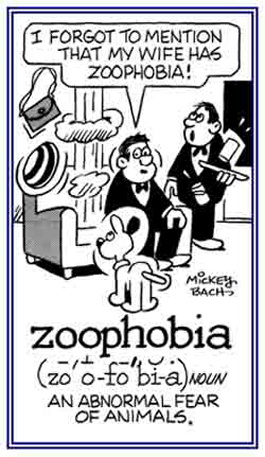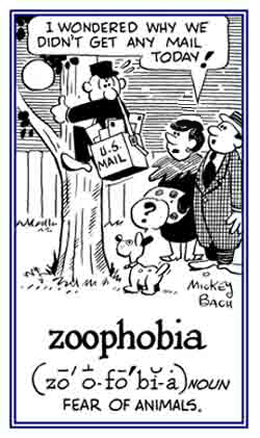zoo-, zoa-, zo-, -zoic, -zoid, -zoite, -zoal, -zonal, -zooid, -zoon, -zoa, -zoan
(Greek: animal, animals; living beings; life)
1. The condition of having a special fondness for animals: Zoophily is present when a person has more love for animals than for people.
2. The opposition to any animal experimentation: People who believe in zoophily are opposed to the cruelty pf animals, specifically antivivisectionism.
3. In biology, pollination by animals: Zoophily applies to plants whose seeds are disseminated by the agency of fauna.
2. The opposition to any animal experimentation: People who believe in zoophily are opposed to the cruelty pf animals, specifically antivivisectionism.
3. In biology, pollination by animals: Zoophily applies to plants whose seeds are disseminated by the agency of fauna.
1. A morbid detestation of animals in general, or of some specific animal: According to an article in a German newspaper, a police officer was going for a walk in the woods with his wife and their three dogs. A stranger, who lived in the forest, was following them and when the couple stopped, the man also stopped because he had zoophobia and was abnormally fearful of being close to the dogs.
2. Etymology: from Greek zoo, "animal" + phobia "fear."

© ALL rights are reserved.

© ALL rights are reserved.
Go to this Word A Day Revisited Index
2. Etymology: from Greek zoo, "animal" + phobia "fear."


Go to this Word A Day Revisited Index
so you can see more of Mickey Bach's cartoons.
zoophobic (adjective), more zoophobic, most zoophobic
1. A reference to the avoidance of animals: There are zoophobic plants which are protected by spines, hairs, secretions, etc. which prevent creatures from eating them.
2. Relating to the dread of certain animals: The most common zoophobic feelings of people are related to dogs, cats, snakes, spiders, rats, and mice.
2. Relating to the dread of certain animals: The most common zoophobic feelings of people are related to dogs, cats, snakes, spiders, rats, and mice.
zoophysical (adjective) (not comparable)
Descriptive of an animal that resembles a plant: A sea anemone, a sponge, or a coral are zoophysical organisms that have the aspects and features of certain vegetation.
The study of animal physiology and form: Zoophysics deals with the bodily structure of animals and the comparative anatomy of them.
The vital physical processes and functions of animals: Zoophysiology deals with the biological performance of living organisms characterized by voluntary movement, but not those of the humans.
Any of various invertebrate animals that resemble plants in morphology (form) or mode of life more than that of an animal: The sea anemones, corals, and sponges are considered to be zoophytes.
Sponges, for example, are just barely animals. In fact, they are such a borderline case that until the nineteenth century they were called zoophytes, the animal-plants. Sponges are among the most primitive forms of multicellular animal life.
zoophytic (adjective) (not comparable)
Pertaining to an animal possessing the aspects of a plant: Such zoophytic creatures are normally invertebrates of the earlier group termed Zoophyta, of which the sponges, corals, and sea anemones are members.
zoophytological (adjective) (not comparable)
Referring to the natural history of those animals possessing the characteristics of plants: In the biology book Mary had, zoophytological aspects of crinoids were scientifically explained.
The branch of zoology concerned with the animals thought to have the aspects or characteristics of plants: Susan decided that she wanted to specialize in zoophytology and be an expert in the research of crinoids, along with corals, sponges, and sea anemones.
The biological study of tiny creatures that exist in oceans: Since Peter was so interested in small lifeforms of the sea, he decided to study zooplanktology and work later as a scientist.
1. Floating animal organisms collectively: Tiny creatures, or zooplankton, consist of rotifers, copepods, and krill, or microorganisms once classified as animals, such as dinoflagellates and other protozoans.
2. A small animal organism present in natural waters: The majority of zooplankton are little crustaceans, for example, copepods and krill, arrowworms, and gelatinous creatures that feed primarily on phytoplankton.
3. Microscopic animals that move passively in aquatic ecosystems, such as, protozoans: To the zooplankton belong the protozoa, the sea anemones, the corals, and the incredibly shaped jellyfishes.
4. Microscopic drifting lifeforms much of which live on or near the surface of the water, but some are at greater depths: The zoologist was studying zooplankton and the nutritional requirements and efficiencies of food conversion of marine animals, or zooplankters, feeding on marine phytoplankters or on other small animals.
2. A small animal organism present in natural waters: The majority of zooplankton are little crustaceans, for example, copepods and krill, arrowworms, and gelatinous creatures that feed primarily on phytoplankton.
3. Microscopic animals that move passively in aquatic ecosystems, such as, protozoans: To the zooplankton belong the protozoa, the sea anemones, the corals, and the incredibly shaped jellyfishes.
4. Microscopic drifting lifeforms much of which live on or near the surface of the water, but some are at greater depths: The zoologist was studying zooplankton and the nutritional requirements and efficiencies of food conversion of marine animals, or zooplankters, feeding on marine phytoplankters or on other small animals.
A living substance which depends on the products of other living organisms for nutritive material: Zooplasm is one kind of bioplasm that is important for sustaining the animal forms of life, as distinguished from phitoplasm for plants, anthropoplasm regarding humans, and petroplasm which pertains to minerals.
zooplastic (adjective) (not comparable)
Concerning the method of transferring tissue from an animal to a human: The zooplastic techniques the doctor told Jean about were still in the process of being tested and would probably be a regular approach to skin transplants in a few years.
1. The process of surgically grafting tissue from a lower animal onto the human body: The article in the newspaper about zooplasty was extremely interesting and thought to be a way to heal skin diseases.
2. The surgical transplantation of an animal organ into a person's body: The professor talked about zooplasty of being a future possibility of transferring a pig’s heart into a human body, but nobody believed him!
2. The surgical transplantation of an animal organ into a person's body: The professor talked about zooplasty of being a future possibility of transferring a pig’s heart into a human body, but nobody believed him!


